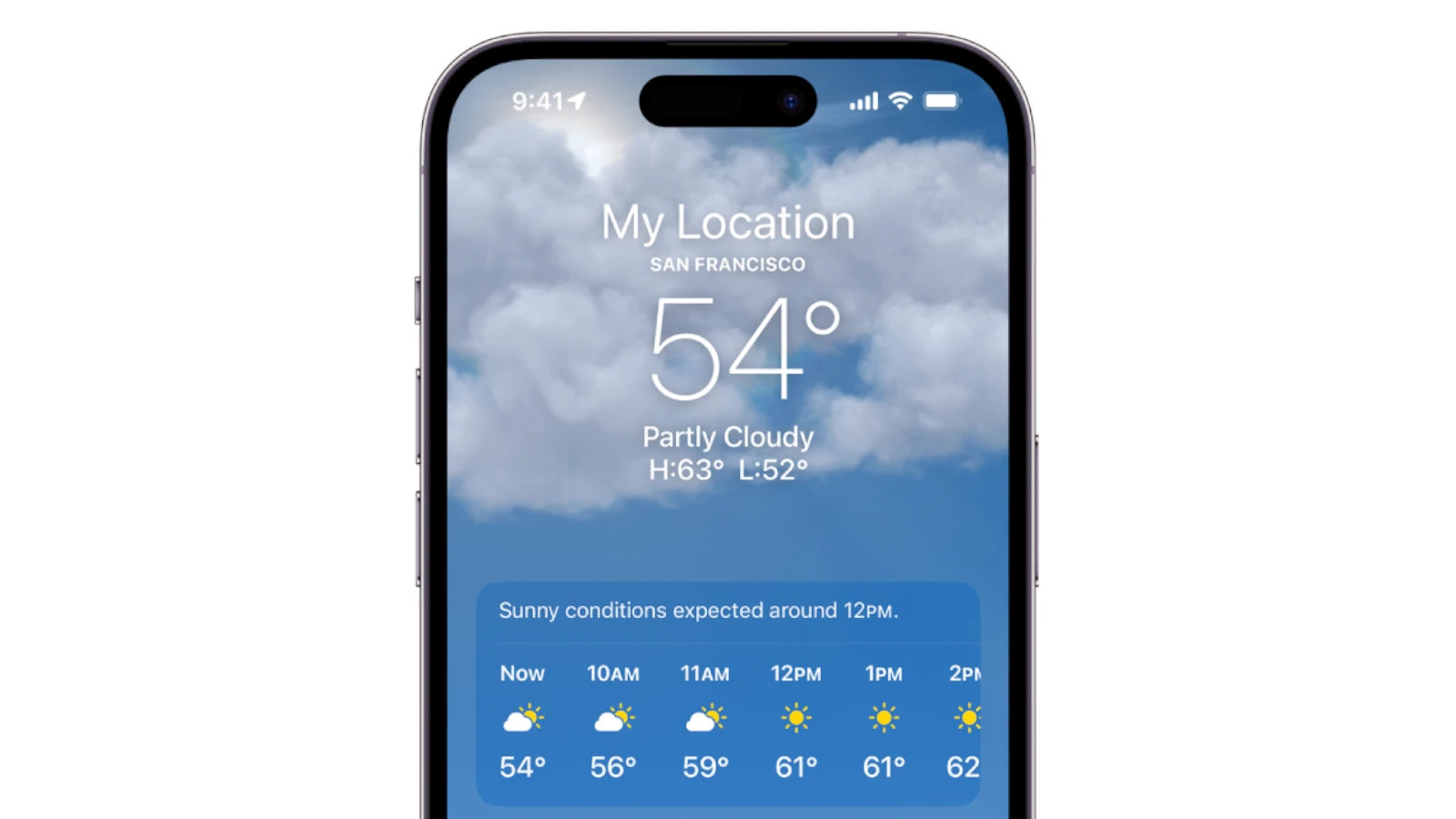Weather apps and features are getting smarter and more sophisticated in 2025-2026. Major tech companies like Tesla, Apple, and The Weather Channel have rolled out significant updates to their weather services, adding customizable interfaces, detailed forecasts, and advanced radar overlays.
New Weather Features Coming to iPhone in the Latest iOS Update (iOS 26)
Apple’s latest iOS update — iOS 26, released in fall 2025 — brings several exciting upgrades to the Weather app. Whether you’re tracking daily forecasts, planning a trip, or monitoring severe weather alerts, the new Weather experience on iPhone is more dynamic, accurate, and intelligent than ever.
In this guide, we’ll explore all the new Weather features coming to iPhone with iOS 26 and how they make staying informed about the elements easier than before.
🌤️ 1. Smarter, More Detailed Forecasts
The Weather app in iOS 26 now delivers hyperlocal forecasts with improved accuracy and precision. Apple has refined its data models using Apple Weather, which combines information from multiple global and regional sources for better real‑time updates.
You’ll now see:
- Minute‑by‑minute precipitation forecasts with improved accuracy
- Enhanced air quality and pollen data for more regions
- Real‑time UV index and humidity tracking
- Expanded forecast graphs, giving you a clearer view of temperature, wind, and pressure trends
(source: Apple Support – Weather App Data Sources)
⚡ 2. New Severe Weather Alerts and Safety Notifications
Apple has expanded severe weather alerts in iOS 26 to cover more countries and regions. These alerts are powered by local meteorological agencies and delivered directly to your iPhone with high‑priority notifications.
New in iOS 26:
- Storm tracking overlays on the map view
- Real‑time lightning detection and strike proximity alerts
- Flood and wildfire warnings with safety recommendations
- Custom alert preferences, letting you choose which alerts to receive
🌍 3. Interactive Weather Maps with 3D Layers
The Weather app’s map view has been redesigned with a stunning new 3D interface. This allows you to visualize weather patterns more intuitively.
You can now:
- Zoom and tilt the map for a 3D perspective of terrain and cloud cover
- Toggle between precipitation, temperature, and air quality layers
- Use animated radar playback to see how conditions evolve over time
This feature is especially useful for travelers and outdoor enthusiasts who want a more immersive view of upcoming weather systems.
🧠 4. Apple Intelligence Integration
With iOS 26, the Weather app now works seamlessly with Apple Intelligence, Apple’s on‑device AI system.
You can ask Siri or type in the new Apple Intelligence prompt field:
“Will it rain before my meeting?”
“What’s the best time to go for a run today?”
Apple Intelligence analyzes your local weather data, calendar events, and location to provide personalized, context‑aware weather insights — all processed privately on your device.
(source: Apple – iOS 26 New Features PDF)
🌡️ 5. Redesigned Widgets and Lock Screen Integration
The Weather widgets on iPhone have been redesigned in iOS 26 for better glanceability and customization.
New widget features include:
- Dynamic backgrounds that match current conditions (e.g., rain, snow, sunshine)
- Expanded hourly forecast widgets for quick updates
- Lock Screen weather summaries, showing temperature and conditions without unlocking your phone
If you use StandBy Mode, you’ll also see live weather updates displayed on your iPhone while charging.
🌅 6. Historical Weather Insights
For the first time, Apple has added historical weather data to the iPhone Weather app. You can now review past conditions for a specific date and location — perfect for comparing seasonal patterns or planning future trips.
🌦️ 7. Improved Accessibility and Regional Coverage
Apple continues to expand the Weather app’s reach and accessibility:
- VoiceOver enhancements for better spoken descriptions of forecasts
- Expanded data coverage in more countries and languages
- Improved contrast and color options for users with visual sensitivities
(source: Apple Support – About iOS 26)
📱 How to Get the New Weather Features
To access these features:
- Go to Settings → General → Software Update.
- Download and install iOS 26 (available for iPhone XS and newer).
- After updating, open the Weather app to explore the new layout and features.
☀️ Final Thoughts
The Weather app in iOS 26 is more powerful, intelligent, and visually engaging than ever. With real‑time alerts, 3D maps, AI‑powered insights, and expanded data coverage, Apple has turned a simple utility into a comprehensive weather companion for everyday life.
Whether you’re planning your day, a hike, or a vacation, the new Weather experience on iPhone helps you stay one step ahead of the forecast.
Key Takeaways
- New weather features from major tech companies bring enhanced forecasting accuracy and detailed radar data
- Mobile weather apps now offer more personalized experiences with customizable interfaces
- Advanced weather tracking capabilities help users make informed decisions about their daily activities
Innovations in Weather Forecasting Technologies
Modern weather forecasting has transformed through cutting-edge technologies like artificial intelligence, augmented reality, and enhanced user interfaces. These advances give users more accurate and engaging ways to track weather conditions.
AI-Derived Weather Insights
Google’s DeepMind has created GenCast, an AI model that produces faster and more accurate 15-day weather predictions than traditional methods. The system processes vast amounts of atmospheric data in minutes.
Weather providers now use machine learning algorithms to analyze patterns from historical data, satellite imagery, and ground sensors. This integration has improved forecast accuracy by up to 30% for 7-day predictions.
The Weather Channel leverages AI to generate hyper-local forecasts. Their system breaks down cities into 500-meter grids for precise temperature and precipitation predictions.
Augmented Reality in Weather Apps
AR features now let users visualize weather data in their immediate surroundings. The Weather Channel app shows rain clouds, storm systems, and temperature variations through the phone’s camera view.
Users can point their devices at the sky to see real-time weather data overlaid on their environment. This includes wind direction arrows, precipitation intensity, and lightning strike locations.
3D weather maps display multiple layers of data simultaneously. Viewers can rotate and zoom through different atmospheric levels to understand weather patterns.
Enhanced User Interface and Navigation
Weather apps have adopted simplified navigation systems with intuitive gesture controls. Users can swipe between hourly, daily, and weekly forecasts effortlessly.
Color-coded weather alerts make severe weather warnings more noticeable. Red signals immediate danger, while yellow indicates potential hazards.
Customizable dashboards let users select their most important weather metrics. They can arrange temperature, humidity, UV index, and air quality data based on personal preferences.
Stargazing and Celestial Events Reporting
Weather apps now include specialized features for astronomical viewing conditions. Cloud cover forecasts help stargazers plan optimal viewing times.
Light pollution maps guide users to dark sky locations. The apps calculate visibility ratings for specific celestial events like meteor showers and eclipses.
Integration with satellite tracking provides real-time updates on visible passes of the International Space Station and other spacecraft. Users receive notifications for peak viewing opportunities in their area.
Frequently Asked Questions
Weather apps and services continue to expand their capabilities with radar improvements, customizable alerts, and high-resolution forecasting tools across iOS and Android platforms.
What are the latest additions to weather apps for iOS devices?
The Weather Channel iOS app version 12.21 introduces enhanced radar features with faster updates and improved visualization. Users can access augmented reality weather overlays for an immersive experience.
Location-based notifications provide instant alerts about changing weather conditions. The radar displays now show four times higher resolution imagery.
How do weather features in the latest Android updates improve user experience?
Android weather apps now integrate with home screen widgets for real-time weather updates. Push notifications arrive faster with more precise local warnings.
The radar refresh rate has increased to every 2 minutes in most locations. Gesture controls make navigation simpler and more intuitive.
Which weather apps are known for their precision and accuracy?
AccuWeather leads in forecast accuracy with its MinuteCast technology. The National Weather Service provides official government data through its mobile platform.
NOAA Weather Radio services integrate with modern apps to deliver immediate severe weather alerts. Local storm reports enhance prediction reliability.
What functionalities are included in Google’s latest weather app update?
Google Weather now features AI-powered precipitation predictions. The interface displays hourly forecasts with precise timing of weather changes.
Street-level weather mapping shows hyper-local conditions. Voice commands enable hands-free weather updates through Google Assistant.
Are there any new weather prediction features launched in the year 2025?
Machine learning algorithms now predict micro-climate variations within cities. Satellite data integration provides more accurate long-range forecasts.
Personal weather stations connect directly to apps for neighborhood-specific data. UV index predictions now account for building shadows and reflections.
Can users access advanced weather services for free, and which apps provide them?
The National Weather Service offers comprehensive radar data at radar.weather.gov without charge. Free weather apps include basic versions of Dark Sky and Weather Underground.
Basic NOAA weather radio alerts remain free through supported apps. Many premium features unlock with ad-supported versions.







